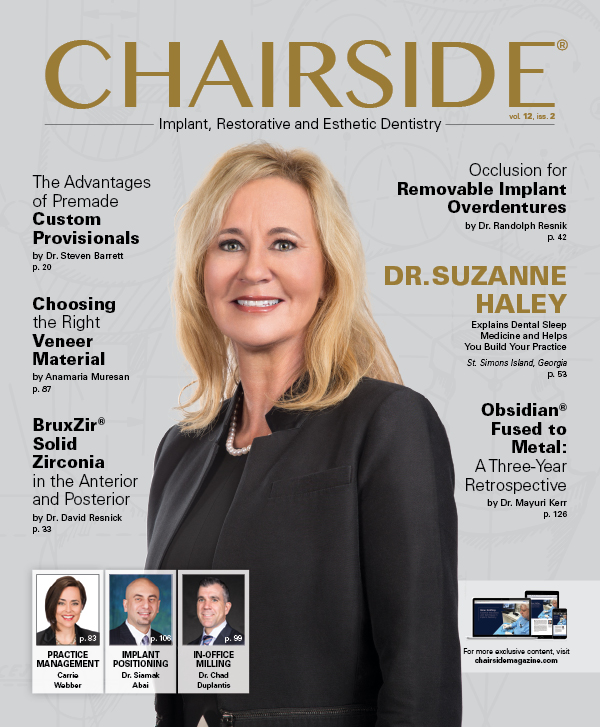Rodolfo Castillo: The Unsung Hero of Obsidian® Lithium Silicate Ceramic
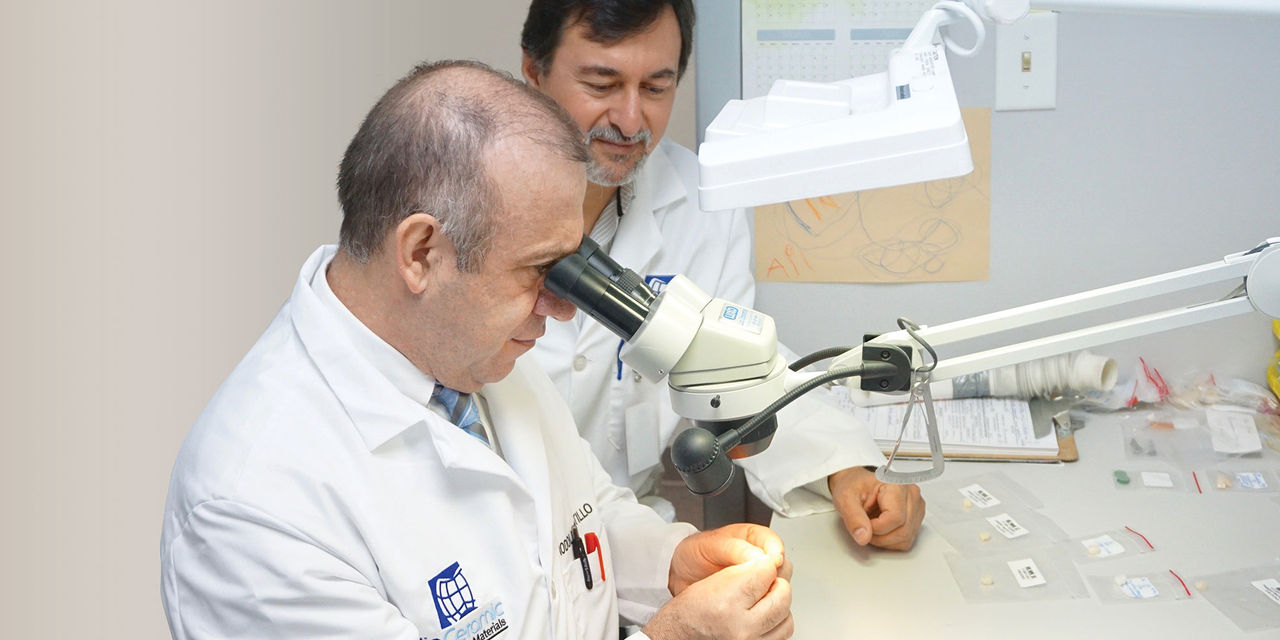
The science of dental ceramics requires a special breed of researcher. There are few standardized rules or textbooks to follow, and even fewer experts who can teach you. Researchers are forced to make their ideas a reality through intense trial and error, mainly unaided by a larger scientific community. More difficult still, the characteristics most desirable for dentistry — esthetics, strength and biocompatibility — are complex to achieve in harmony. Untold years of research and development are spent on materials that will ultimately never pass muster and never be prescribed by clinicians.
In the early 2000s, the dental industry saw the release of a new generation of monolithic glass ceramics. These monolithic materials delivered qualities thus far unseen in tooth-colored restorative options, leading many to question the continued use of weaker feldspathic PFMs. Among those was Glidewell Dental President and CEO Jim Glidewell, CDT, who was so impressed by the new beautiful glass ceramics that he directed his company’s research division to focus on developing a high-strength monolithic material that wouldn’t compete directly against them, but rather was indicated for cases in which glass ceramics weren’t suited. Out of that thrust ultimately came BruxZir® Full-Strength Solid Zirconia, the monolithic zirconia that’s been prescribed more than 14 million times in just eight years. However, in the early stages of BruxZir zirconia’s development, Jim realized that even zirconia would have certain limitations, necessitating the development of a ceramic material that shared the esthetic and strength qualities of the glass ceramics while also being pressable to metal to help clinicians move away from feldspathic PFMs.
Enter Rodolfo Castillo, the only dental ceramic engineer in Florida who didn’t already work for one of the major materials manufacturers. Rodolfo agreed with Jim that for bilayered restorations to have a future, their principal failing — the weakness of feldspathic porcelain — must be addressed. Finding common ground, Jim and Rodolfo set forth on a decadelong journey that would culminate with the release of Obsidian® lithium silicate ceramic and Obsidian Fused to Metal.
SETTING THE STAGE
Born and raised in Bogotá, Colombia, Rodolfo earned a bachelor’s and master’s in chemical engineering from the Universidad Nacional de Colombia in Bogotá. He later took a research position at KU Leuven, a leading European research university in Belgium, where he worked on solid-state chemistry and nanochemistry projects, gathering experience that eventually led him to a small dental manufacturing company in the U.S. There, he met an associate of Jim Glidewell who arranged an introduction, knowing that Rodolfo’s expertise and Jim’s visionary insight could lead to the development of groundbreaking materials.
With the help of Jim Glidewell, Rodolfo opened a small facility in South Florida and recruited biomedical engineer Victor Guerra and a few lab workers who would be dedicated entirely to developing a new glass-ceramic material. There were two main goals: first, to develop a strong, monolithic glass ceramic that could be made into CAD/CAM blocks; and secondly, to have that material be pressable to metal. Further complicating the task, once the initial formulation was developed, the team would need to adjust the formulation 16 times in order to match all of the VITA® Classical shades (VITA Zahnfabrik; Bad Säckingen, Germany) commonly prescribed by clinicians.
The newer generation of ceramics employed in clinical dentistry requires a distinct set of characteristics to be marketable, including the following: a balance of opacity and translucency; toothlike coloration; toughness to withstand intended function as well as parafunctional habits; and unit-to-unit consistency. Rodolfo knew that to achieve all of these attributes across 16 formulations would take years of precision engineering, and that there was a very real possibility that another material manufacturer would release a superior material in that time frame that would render his efforts wasted. Jim and Rodolfo, however, saw that the clinical need for a feldspathic porcelain replacement was too immediate an issue to leave the solution up to chance. If someone else were to develop it, dentistry would benefit, but the secretive nature of competing research teams meant there was no certainty that anyone was trying to find a solution to the particular problem.
THE EARLY DAYS
The original area of research centered around the element germanium, which is chemically similar to the silicon used in many glass ceramics. With hopes of creating a lithium digermanate material, Rodolfo studied germanium oxide and added quantities to the test formulations. After some early development and research, Rodolfo created a number of sample ceramics and sent them to a laboratory for chemical identification via X-ray diffraction. The results indicated that the materials were in fact lithium silicate, and that the added germanium oxide wasn’t actually establishing the desired lithium digermanate chemical formula. The team abandoned the idea of forming a lithium digermanate that satisfied the desired qualities for clinical dentistry; from there, they turned their research toward the promising realm of lithium silicate.
THE CHALLENGES OF DEVELOPING NEW DENTAL CERAMICS
Rodolfo and his team, supported by Jim Glidewell, began many months of in-depth research. It was important that the team had a thorough understanding of the chemistry involved with the glass-ceramic materials that were already proving themselves in the industry, as well as feldspathic porcelains. This period helped the researchers better define the problem, ultimately allowing them to come to the early development phases with a plan in hand.
Undeterred by industry naysayers and equipped with a comprehensive knowledge of proven dental ceramics, Rodolfo and company moved full force into attempting to develop their new lithium silicate material. One major challenge in creating a dental ceramic is that the material has to satisfy myriad demands all at once: it must be esthetic; it must be strong; the process must be repeatable; and it must have a low chemical solubility to withstand erosion caused by fluids in the oral cavity. Even if his team was able to achieve all of those qualities in unison, the resultant formulation would have to then be further modified to satisfy the array of shades used by clinicians.
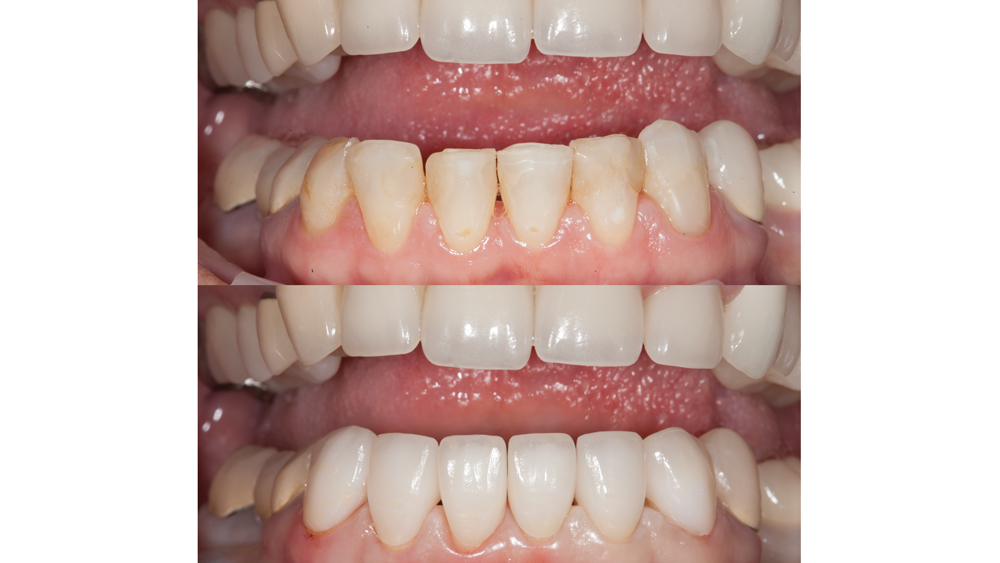
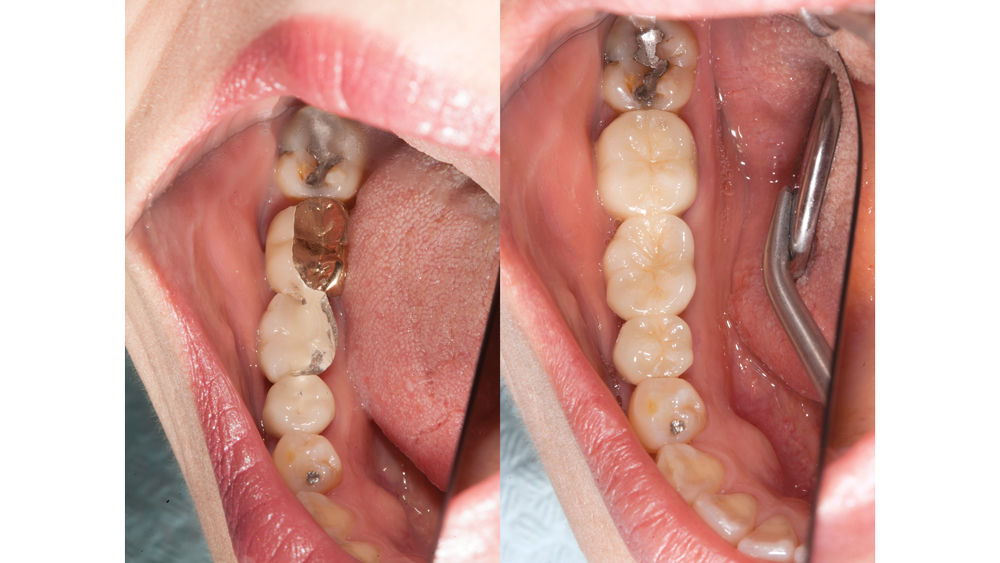
Obsidian lithium silicate ceramic, developed by Rodolfo Castillo and his team, shown in its all-ceramic (bottom left) and fused to metal (far right) forms.
One major challenge in creating a dental ceramic is that the material has to satisfy myriad demands all at once.
The chemical composition of every single shade of Obsidian lithium silicate is distinct. All time and effort spent by Rodolfo and his team developing an A1, for example, would have to be repeated for the remaining 15 shades of the VITA Classical shade guide. Creating an identical set of physical properties across a spectrum of shades with more than 24 elements involved was no simple feat, forcing the team to start from scratch several times over. The end result was 16 shades that share approximately 94 percent of their chemical makeup, with the unshared elements achieving the distinct colorations.
The journey wouldn’t end there, however. While the team’s newly created lithium silicate exhibited a rather unique thermal expansion quality, it wasn’t similar enough to that of commercially available dental alloys. Thermal expansion is important for bilayered restorations during the fabrication process: If the conjoined metal and ceramic react differently to heating and cooling, there’s a significant chance of fracture, breakage and failure. The team realized that they would, in reality, need two completely distinct base formulations: one for millable blocks and one for pressable ingots. Again, the engineers dove into research and began reformulating their newly created lithium silicate in hopes of aligning the thermal expansion quality with those of dental alloys. This reformulation meant that 16 additional sub-formulations would need to be developed again to achieve the distinct shades for the ingot version. Out of that second effort, Obsidian Fused to Metal was born. The pressable formulation, while esthetically matching the millable formulation, was specifically developed for the fused to metal process. The Obsidian brand would have to be comprised of two base formulations.
Once all 32 sub-formulations were finalized, Rodolfo and his team turned toward their final hurdle: creating manufacturing processes that could be implemented at Glidewell Dental. When a new dental ceramic is developed, there are no off-the-shelf workflows for materials manufacturers to employ. Rather, the engineers must develop the complex manufacturing chain largely from scratch. Computer systems, instruments, machines and casting devices all had to be gathered, customized and arranged to prove it was viable and profitable to manufacture the material. Every single step of creating the lithium silicate, from raw product to finished restoration, had to be developed, validated and streamlined in South Florida by Rodolfo and his team.
Every single step of creating the lithium silicate, from raw product to finished restoration, had to be developed, validated and streamlined in South Florida by Rodolfo and his team.
Nearly 10 years on, the original goals have been achieved, marked by the releases of Obsidian lithium silicate and Obsidian Fused to Metal.
CHANGING DISAPPOINTING RESULTS INTO PROGRESS
After the release of Obsidian lithium silicate, Rodolfo admitted that he had at times doubted whether the feat was possible, but was too persistent and committed to voice his concerns. Long periods of the development were fraught with disappointment that overshadowed the mere inches of progress. He attributes his team’s success to their collective personalities, which would not tolerate giving up easily. Their meticulous, consistent work was fueled by dogged determination.
While Jim Glidewell attributes the successful development of the material to the engineering team in Florida, they remain ever grateful for his support. Jim’s belief in the clinical need for such products never wavered, and he gave the engineers ample resources, support and time to achieve their goals.
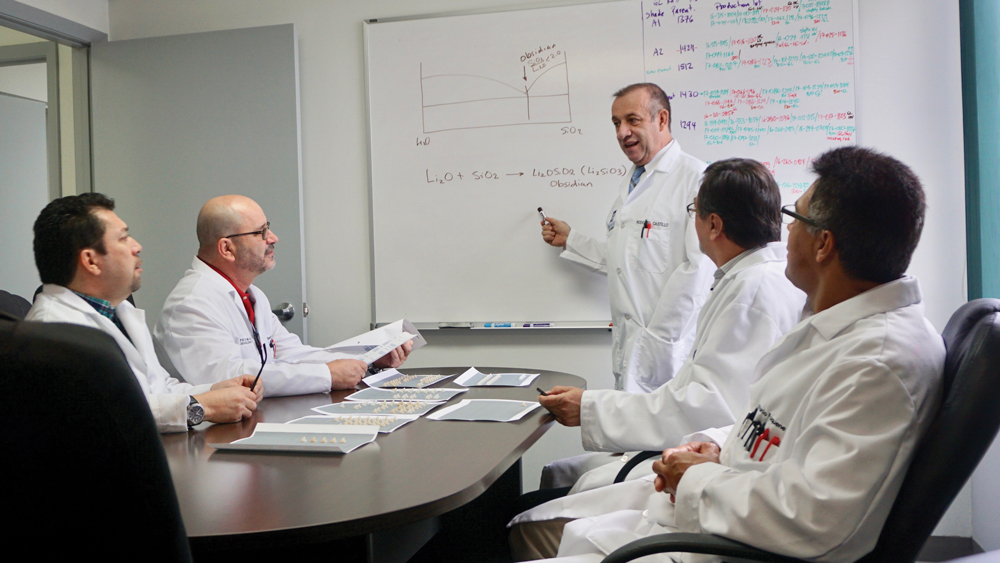
THE PRIDE OF GLIDEWELL DENTAL
Obsidian Fused to Metal represents a major step forward for dentistry. Notwithstanding the wide availability of monolithic glass ceramics, more than 50 percent of restorations prescribed industry-wide today are still feldspathic PFMs. Patients and clinicians deserve to benefit from the advancements made in materials science in recent decades. Obsidian Fused to Metal is more than four times stronger than feldspathic porcelain, and twice as resistant to cracks and fractures. Its natural-looking appearance and shade-matching capabilities position it to be used for cases that demand superior esthetics. And digital-age processes such as the selective laser-sintering technique used to fabricate the metal understructures make for significant improvement in marginal precision.
Obsidian Fused to Metal is more than four times stronger than feldspathic porcelain, and twice as resistant to cracks and fractures.
Engineering and clinical performance studies with Obsidian lithium silicate ceramic have been so promising that Glidewell Laboratories has completely abandoned the use of conventional porcelain and now uses only Obsidian glass ceramic for bilayered restorations. Quite simply, Obsidian Fused to Metal represents the next generation of PFM, updating the industry’s longtime workhorse for the next century.

Were it not for the dedication of Rodolfo, the dental industry would be forced to rely on 50-year-old technology in situations where glass ceramics or BruxZir Solid Zirconia are contraindicated. The development of Obsidian lithium silicate stands as Rodolfo’s proudest achievement in his three-decade long ceramics career, and he urges clinicians to see how Obsidian can benefit their patients and practices. Thanks to Rodolfo and the workers in South Florida, dentistry has a modern solution that’s poised to benefit millions of patients in need of bilayered restorations.

